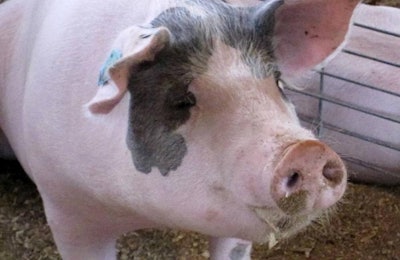
This article appears in the May/June issue of Pig International. View all of the articles in the digital edition of this magazine.
In simple terms, the successful artificial insemination of sows depends on the hygienic deposition of enough sperm at the appropriate time so as to have an adequate sperm reservoir in the oviduct at the time of ovulation.
However, what is the optimal time of insemination? To address this question, current practice is to inseminate sows multiple times, starting at estrus detection and again 24 hours later; a third insemination may be performed after another 24 hours if sows continue to show estrus behavior. Therefore, multiple inseminations are applied for insurance because it increases the chance of one insemination occurring at the optimal time relative to ovulation. On the other hand, multiple services increase the number of boars required and thus decrease the selection pressure on any one boar.
Ovulation inducers
The time of natural ovulation is controlled by the surge of LH near the onset of estrus. Ovulation will occur in 85 to 90 percent of sows 42 ± 2 hours after an injection of human chorionic gonadotrophin (hCG) or 38 ± 2 hours after gonadotrophin-releasing hormone (GnRH).
Therefore, if ovulation is expected to occur 38 or more hours after detection of estrus, such as would be expected following a gonadotrophin-induced estrus or naturally short wean-to-estrus intervals, treatment with GnRH or hCG will provide a high degree of predictability to the time of ovulation.
Recently, new ovulation inducers have been made available. In particular, it has been shown that 200 μg of triptorelin given intra-vaginally to sows at 96 hours after weaning synchronizes ovulation and results in fertility, number of liveborn pigs and farrowing rate similar to controls.
Boar selection
Controlled ovulation technologies can be effectively employed in boar selection. Ideally, stud boars should be screened using single-sire semen doses with fewer sperm cells (e.g., 0.75–1.0 x 109 sperm cells) with the confounding effect of timing of semen deposition removed by controlling time of ovulation. Boar selection should emphasize the economics of breeding: reductions in feed conversion efficiency, lower carbon footprint and better carcass quality.
Cost and labor
There are considerable economic benefits of the use of single fixed-time insemination, the most obvious being the cost savings from the reduction in breeding time. If the time taken to breed a sow is assumed to be 3 minutes, on a 900 sow unit (40 sows a week to wean) breeding once versus twice reduces the annual workload per year by over 7,500 minutes. With an eight-hour workday, this is an annual saving of 15 days in addition to a 50 percent reduction in semen costs.

A single insemination of sows, enabled by ovulation synchronization, saves on labor, cost and allows for better use of high-value boars.
Semen value
Many producers may consider the potential saving of semen value to be important, but this may be a false economy. If producers shift their breeding focus towards finishing values rather than sow values, the farm is able to reap greater profit benefits. On the example farm with 40 sows a week to wean, the farm produces 480 weaners a week. A reduction in feed conversion rate (FCR) of 0.1 will save the farm nearly 300 metric tons of finishing feed per year. An improvement in carcass meat content of 1 percent would produce an additional 30 metric tons of pig meat. With enhanced selection, benefits in litter size and growth rates or meat quality can be realized.
Non-productive days
The reproductive performance of a sow herd may be affected by a variety of factors, with non-productive days being an important metric for the sow herd efficiency. A non-productive day is any day that a sow, or a gilt once entered into the breeding herd, is neither pregnant nor nursing a litter. Non-productive days can reduce the number of possible productive days, limiting the potential number of litters per year. It has been estimated that one non-productive day can cost about $3.24, including feed costs and the lost potential profit from “non-produced” pigs. The adoption of single fixed-time insemination can contribute to reducing non-productive days, particularly by controlling the wean-to-service interval in sow herds.
Learn more: Nutrition guidelines for feeding breeding boars

















